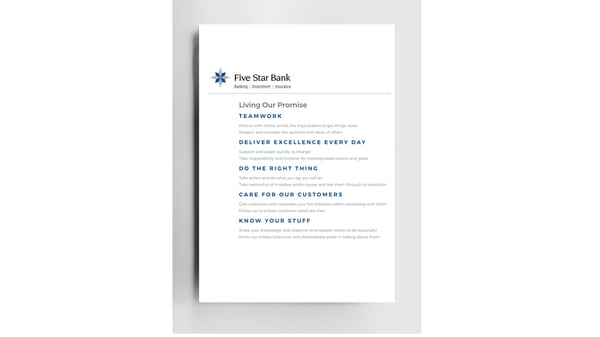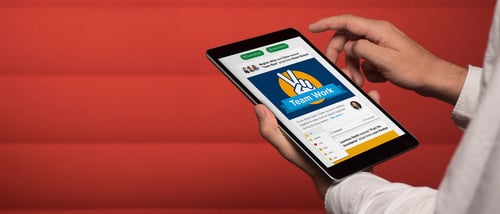%20(1).jpg?width=500&name=Louis%20Kwakye%20-%20Tom%20Conran-1675%20(2)%20(1).jpg)
6 min read
We all know that recognition is a key component for a healthy work environment and is one of the ways to give people what they crave at work so they are more motivated, committed and engaged.
Seventy percent of workers say that motivation and morale would improve if managers simply said 'thank you' more.
And we know that a lack of recognition is one of the reasons why employees look for a new job. But what might not be as widely known and understood is that recognition can also be used as a strategic tool for encouraging your team to perform (and showing them how to perform) in ways that support your company values and drive tangible results for your business.
Take a moment and imagine this: Imagine if everyone in your organization fully understood your company values, mission and/or purpose and worked to consistently deliver on them each day through their day-to-day actions and interactions.
Consider the impact it would have on:
| You: | "I'm more likely to get support when I need it." |
| Your customers: | "Our customers will get the same message and level of service no matter who they interact with." |
| Your company: | "We can save time and money for the company, when we do things right the first time." |
And the effect on your business can’t be ignored.
Employee turnover costs companies up to $11 billion annually, and 77% of employees who understand what their company stands for and what makes it different from competitors also strongly agree that they’ll stay with the company for at least one year, according to a study from Gallup.
But it doesn’t have to exist solely in your imagination. You can inspire your team to work according to your values, mission and/or purpose by sharing why they are important, setting expectations for how they can do so and incorporating them into your recognition efforts. Here are a few ideas to get you started:

First, concentrate on sharing the why
Chances are, you already have established company values, a mission and/or purpose. Your core values serve as a guideline for who you are as a company, what you do and why it is meaningful.
They are the underlying mindset and attitude that people should have when coming to work each day.
And they can make a real difference in helping direct your team to achieve the results that are most important to your company. Take, for example, Five Star Bank, a financial services provider that was struggling to grow its business and its team in a way that was consistent with being a great place to work and do business with.
The leaders worked to refine the existing value set with more intentional definitions and specific, measurable behaviors. Its newly defined values, combined with its strategic recognition program, drove a number of financial outcomes: an improved ranking in the community, improved customer satisfaction and an NPS that is 2.5 times higher than the industry average.

Plus, leaders were able to educate the workforce on the values and behaviors and reinforce them through ongoing recognition. The organization used its employee engagement program to encourage peer-to-peer and manager-led recognition.
Sharing stories of individual and team success helped the whole team better understand how they could live the company values, and also feel empowered on how to recognize their peers for behaviors, too.
So take a few minutes to revisit your values. Are they still representative of who you are as an organization? Do your values speak to your team? Does your team understand what they mean and how they can deliver on them?
If not, it might be time to sit down and revamp your company values so employees can connect with the greater purpose and importance of what they do every day. And, when you do so, make sure to support your values with “the how.”

Next, use behaviors to set expectations for how to live your values
Make sure your team understands how they can and should bring your values to life. Define the actions that support your values through specific behaviors. Defining behaviors in support of your company’s more aspirational values, mission and purpose helps take them “off the wall” and make them real, achievable things your team can work toward.
One way to create your list of behaviors is to ask a group of employees (thought leaders and champions from different areas of your company) to share a few behaviors that represent them or another team member “on their best day.”
What is it that the person does that makes them a great person to work with? Or, what is it that the person does to delight customers?
This exercise should give you more than enough examples to craft the top 10 or 20 behaviors that support your values.
Once you have your top behaviors, share them with your team. Whether that means posting them on your company’s website, incorporating them into a culture book or internal messaging, clearly communicate your company values and make sure they’re visible and easily accessible for all employees.
The more your people can see and interact with your values, the more likely they are to embrace them and truly live them day in and day out. And what is the best way to do that? Consistently share examples of people demonstrating your values through your recognition program.

And finally, encourage and celebrate your company values through recognition
Use recognition to invite your team to share stories about your values and the behaviors that support them in action. For the greatest impact, encourage your team to follow the steps that make recognition a little more strategic than just saying “thank you.”
| Three steps to make employee recognition more strategic |
| Step one: Tell the action |
| Step two: Connect to an area of focus or company value |
| Step Three: Explain the impact |
Your recognition program is an excellent tool for bringing different locations, departments, working groups, etc., together on one platform where they can learn from and celebrate each other’s successes.
Our clients use filtering/sorting on their social feeds to quickly drill down into the different groups and see where employees are living the values and behaviors, as well as uncover where the team might need a little more encouragement.
.jpg?width=500&name=Reward%20Gateway%20Event%20-42%20(1).jpg)
Recognition can be really helpful if your company is struggling with upheaval. In particular, one of our clients, Lifetime Healthcare Companies, used recognition when they were experiencing some inconsistencies in their culture and work environment due to changes in leadership.
The organization had a recognition program in place, but it felt stagnated and wasn’t in line with the goals that the team and company considered important.
To refresh its offering, Lifetime Healthcare Companies re-examined and refined its values and behaviors.
The organization then rolled out a new employee recognition program, with tailored communications, and shared cross-departmental success stories to increase visibility of the values and to celebrate success.
In addition, employee engagement scores have increased by 47% since its initial engagement survey as teams have found they are better able to work collaboratively to celebrate wins and pinpoint areas of opportunity to grow and improve their business.
Building your values and the behaviors that support them is the first step toward a strong culture. Reinforcing those values and behaviors through continuous, strategic recognition is the best way to ensure those values become embedded in everyone’s day-to-day actions and interactions.
The results will speak for themselves!

%20(1).jpeg) Alexandra Powell
Alexandra Powell

